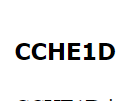Quoted from: https://webspace.clarkson.edu/~wwu/CCHE1D.html
CCHE1D is a one-dimensional (1D) model for simulations of unsteady flows, sediment transport, pollutant transport, water quality, ecosystem and ecotoxicology in dendritic channel networks. The flow and sediment transport model was developed by Wu et al. (2004), through significant improvements on its earlier versions. The hydrodynamic module solves the 1-D St. Venant equations, including special procedures to account for the effects of hydraulic structures, such as culverts, drop structures, bridge crossings, and measuring flumes.
The sediment transport module computes the non-equilibrium transport of nonuniform total load. The equations of sediment transport, bed changes, and bed material sorting are solved in a coupling procedure with a direct solution technique, while decoupled from the flow model. The sediment transport capacity is calculated by one of four formulas, which take into consideration the hiding and exposure mechanism of nonuniform bed material. Bank toe erosion and mass failure are simulated to complement the modeling of bed morphological changes in channels.
The water quality and aquatic ecology/ecotoxicology module was incorporated into CCHE1D by P. Inthasaro (2010) supervised by W. Wu. The water quality module alone can be used to determine water temperature, dissolved oxygen, biological oxygen demand, nitrogen, phosphorus, and conservative chemical such as chloride. The aquatic ecosystem module considers a basic food web structure consisting of four trophic levels: phytoplankton, zooplankton, forage fish, and predatory fish, undergoing various biological processes such as photosynthesis, grazing, respiration, excretion, defecation, mortality, gamete, and reproduction. The model simulates the bioaccumulation of toxic chemicals in organisms by uptake, depuration and dietary, and takes into account the effects of toxicity on organisms through modification factors of photosynthesis, grazing, and gamete mortality.
CCHE1D has been designed to facilitate the combined modeling of watershed and channel processes. It can be used with watershed models AGNPS and SWAT. An ArcView GIS graphical interface facilitates the data management and the integration of the channel model with watershed models and other tools. It also includes a landscape analysis module that delineates the drainage network and corresponding subcatchments based on digital elevation data.
CCHE1D is maintained by the National Center for Computational Hydroscience and Engineering, University of Mississippi. The released version calculating flow and sediment transport can be downloaded at http://www.ncche.olemiss.edu/sw_download. The technical and user manuals are Wu and Vieira (2002) and Vieira and Wu (2002).
References:
W. Wu, D. A. Vieira, and S. S.Y. Wang (2004). “A 1-D numerical model for nonuniform sediment transport under unsteady flows in channel networks,” J. Hydraulic Eng., ASCE, 130(9), 914–923.
W. Wu and D. A. Vieria (2002). “One-dimensional channel network model CCHE1D 3.0 -- technical manual,” Technical Report No. NCCHE-TR-2002-1, National Center for Computational Hydroscience and Engineering, The University of Mississippi.
D. A. Vieira and W. Wu (2002). “One-dimensional channel network model CCHE1D version 3.0 – user’s manual,” Technical Report No. NCCHE-TR-2002-2, National Center for Computational Hydroscience and Engineering, The University of Mississippi.
P. Inthasaro (2010). “A one-dimensional aquatic ecology and ecotoxicology model in river systems.” PhD Dissertation, National Center for Computational Hydroscience and Engineering, The University of Mississippi, Mississippi.








